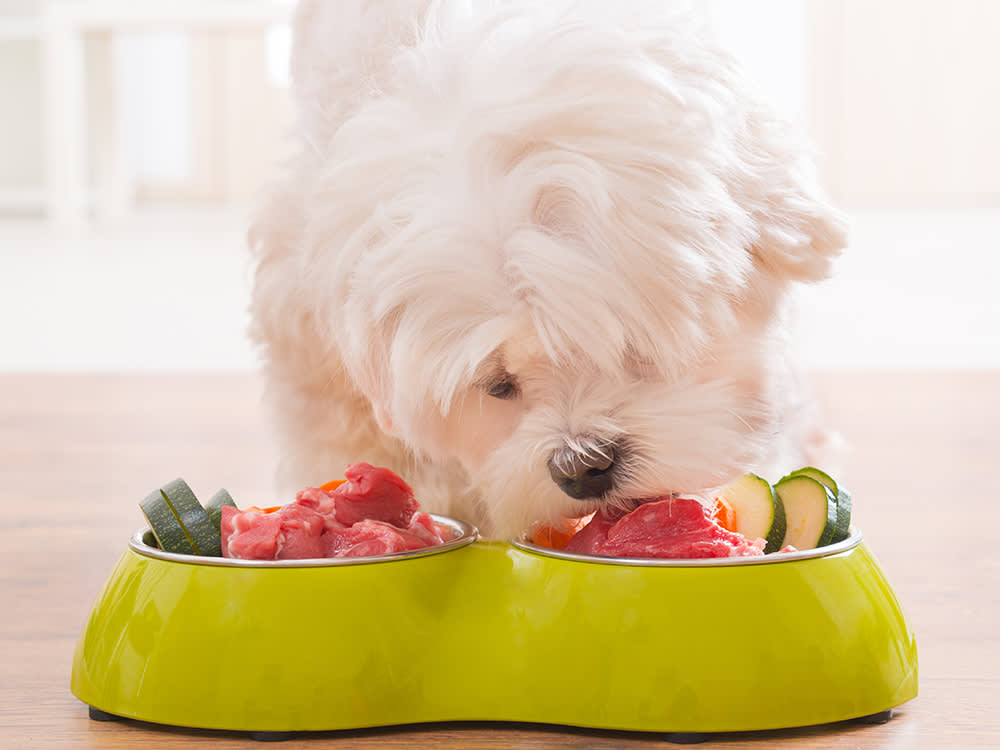The Scoop on Human-Grade Dog Food
For starters, yes, it’s good enough to eat.

Share Article
There are a lot of factors to consider when picking a dog food for your pup. Like, a lot. It can be hard to separate real benefits from marketing buzzwords. High on the list of hype-worthy options are human-grade dog foods. But what does that term mean, and does it matter to your doggo? We did some digging, so you don’t have to.
What exactly is human-grade dog food?
To answer that question, we need to understand the difference between foods classified as “edible” and “inedible” (Hint: It has nothing to do with how the food tastes). Edible foods use ingredients and manufacturing processes that are deemed safe for human consumption. Thus, they are known as human-grade foods. They’re highly regulated throughout every stage of the food production and distribution process to ensure their safety. Inedible foods — aka “feed-grade” foods — include ingredients not fit for humans (poultry by-products, for example) and are laxer when it comes to processing and handling.
Although they’re not considered safe for human consumption, they are suitable for use in pet foods. Feed-grade isn’t inherently less safe when it comes to quality control, but it’s not regulated as closely.
Pet foods that say “human grade” on the packaging are held to a high standard. According to the Association of American Feed Control Officials (AAFCO), “for a product to be human-edible, all ingredients in the product must be human-edible, and the product must be manufactured, packed, and held in accordance with federal regulations in 21 CFR 110, Current Good Manufacturing Practice in Manufacturing, Packing, or Holding Human Food.” Human-grade pet foods come in various forms, including dehydrated, freeze-dried, fresh-cooked, or frozen.

You might also see pet foods that say they use “human-grade ingredients.” That means that some or all of the ingredients used to make the food are human-grade, but somewhere along the road from raw ingredients to finished product, they fell out of compliance as a human-grade food. An example of this would be a product that uses human-grade ingredients but is processed in a pet food manufacturing facility.
Is human-grade dog food good for my pet?
Good question. According to Bridget Meadows, who has worked in quality and safety across pet food brands, “with fresh, human-grade food, you can see exactly what whole foods are in your pup’s bowl. Focusing your dog’s diet on high-quality, whole ingredients can eliminate several health issues your dog might be struggling with, like allergies or digestive trouble.
Of course, not all human-grade pet foods are the same. When selecting any diet for your pet, you want to make sure you’re buying from a reputable company that understands your pet’s nutritional needs. Look for companies that work with a board-certified veterinary nutritionist — or better yet, employ one full time — to develop their recipes.
How does human-grade dog food compare to home-cooked dog food?
“Fresh, human-grade dog food contains the right ingredients for the total nutrition of your dog and is gently cooked to be safe for both people and pets to handle,” Meadows says. “The cooking process also makes the food easier for your pet to digest and absorb all the great nutrients found in each ingredient.”
Wondering if you can just cook your own human-grade dog food at home? You sure can. However, getting the right balance of nutrients is tricky, so you’d want to work with a veterinary nutritionist to ensure you’re meeting your pet’s nutritional needs.
Companies such as Nom Nomopens in new tab not only work with nutritionists to tailor their recipes to your pup but also offer additional conveniences. These include pre-portioned meals that are easy to store and serve, home delivery, and subscription options. And let’s face it: The less time you spend thinking about, making, or buying your dog’s food, the more time you have to hang out with your pal.
Disclaimer alert: This article is here to share information. But, much like pineapple on pizza, the topic may be controversial. Meaning, not all vets or pet professionals agree. Because every pet is a unique weirdo with specific needs. So, don’t take this as fact or medical advice. Talk things over with your vet when making decisions, and use your best judgment (about both your pet’s health and pizza toppings).

Kate Sheofsky
Kate Sheofsky hails from San Francisco, where she developed a love of writing, Giants baseball, and houses she can’t afford. She currently lives in Portland, OR, and works as a freelance writer and content strategist. When not typing away on her laptop, she enjoys tooling around the city with her two rescue pups searching for tasty food and sunny patios.


